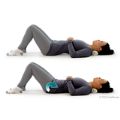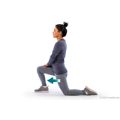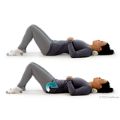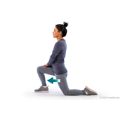Hip Problems, Age 12 and Older
Overview
Hip pain can make it hard to walk, go up and down stairs, squat, or sleep on the side that hurts. A clicking or snapping feeling or sound around your hip joint (snapping hip) may bother you or cause you to worry. But if your hip isn't painful, in many cases the click or snap is nothing to worry about. Home treatment may be all that's needed for minor hip symptoms.
To better understand hip problems, it may be helpful to know how the
Hip problems
Hip problems may develop from overuse, bone changes with age, tumors, infection, changes in the blood supply, or a problem that was present from birth (congenital). Oddly enough, a person who has a hip problem often feels pain in the knee or thigh instead of the hip. The type of hip pain you have may help your doctor find the cause of your pain.
- Pain when resting doesn't get worse with motion or standing. This type of pain is usually caused by a less severe problem, unless the pain doesn't go away or it awakens you from sleep.
- Pain with movement gets worse when you move the hip or leg, but not when you stand or bear weight. This type of pain is most often caused by a muscle injury, inflammation, or infection.
- Pain with weight-bearing gets worse when you stand or walk. It may cause you to limp. This type of pain usually means that you have a problem with the hip joint itself. Pain that's severe enough to prevent any weight-bearing is more likely to mean a serious bone or joint problem.
You may have pelvic, groin, thigh, or knee pain (referred pain) along with a sore, painful, or tender hip. Hip pain can have many causes.
- Snapping pain on the outside of the hip and sometimes the knee may be caused by iliotibial band syndrome. The iliotibial band is a band of fibrous tissue that runs down the outside of the thigh. The band may overdevelop, tighten, and rub across the hipbone or the outer part of the knee.
- Pain in the hip, thigh, or knee of an older child or teen may be caused by conditions such as
slipped capital femoral epiphysisslipped capital femoral epiphysis , in which the upper end of the thighbone (femur) slips at the growth plate (epiphysis), or Legg-Calve-Perthes disease. - Pain that's worse in the morning and improves during the day may be caused by
bones rubbing togetherbones rubbing together . This can happen withosteoarthritisosteoarthritis ,rheumatoid arthritisrheumatoid arthritis , andlupuslupus . - Pain may be a sign of inflammation of the large sac that separates the hipbones from the muscles and tendons of the thighs and buttocks (trochanteric bursitis).
- Pain can occur with signs of infection in a joint (
septic arthritisseptic arthritis ), bursa (septic bursitisseptic bursitis ), or bone (osteomyelitisosteomyelitis ). - Pain and stiffness in the hip may be caused by lack of blood flow to the hip joint (
avascular necrosisavascular necrosis ). You may also have pain in the knee. - Pain that shoots down the leg from the hip or lower back may be caused by an irritated or pinched nerve (
sciaticasciatica ). - Pain with weight-bearing that gets worse over several months may be caused by
transient osteoporosistransient osteoporosis . This is more common in middle-aged men. But it also can affect women in the later part of pregnancy (third trimester). Osteoporosis related to pregnancy usually goes away on its own within a year after the baby is born. - Some types of bone cancer (osteosarcomas) and the spread of cancer to the bone (metastatic disease) can cause bone pain.
Treatment may include first aid and using a brace, cast, harness, or traction. It may also include physical therapy and medicines. In some cases, surgery is needed. Treatment for a hip problem depends on:
- The location and type of injury, and how bad it is.
- Your age, general health, and activities (such as work, sports, hobbies).
Check Your Symptoms
The medical assessment of symptoms is based on the body parts you have.
- If you are transgender or nonbinary, choose the sex that matches the body parts (such as ovaries, testes, prostate, breasts, penis, or vagina) you now have in the area where you are having symptoms.
- If your symptoms aren’t related to those organs, you can choose the gender you identify with.
- If you have some organs of both sexes, you may need to go through this triage tool twice (once as "male" and once as "female"). This will make sure that the tool asks the right questions for you.
Many things can affect how your body responds to a symptom and what kind of care you may need. These include:
- Your age. Babies and older adults tend to get sicker quicker.
- Your overall health. If you have a condition such as diabetes, HIV, cancer, or heart disease, you may need to pay closer attention to certain symptoms and seek care sooner.
- Medicines you take. Certain medicines, such as blood thinners (anticoagulants), medicines that suppress the immune system like steroids or chemotherapy, herbal remedies, or supplements can cause symptoms or make them worse.
- Recent health events, such as surgery or injury. These kinds of events can cause symptoms afterwards or make them more serious.
- Your health habits and lifestyle, such as eating and exercise habits, smoking, alcohol or drug use, sexual history, and travel.
Try Home Treatment
You have answered all the questions. Based on your answers, you may be able to take care of this problem at home.
- Try home treatment to relieve the symptoms.
- Call your doctor if symptoms get worse or you have any concerns (for example, if symptoms are not getting better as you would expect). You may need care sooner.
Pain in adults and older children
- Severe pain (8 to 10): The pain is so bad that you can't stand it for more than a few hours, can't sleep, and can't do anything else except focus on the pain.
- Moderate pain (5 to 7): The pain is bad enough to disrupt your normal activities and your sleep, but you can tolerate it for hours or days. Moderate can also mean pain that comes and goes even if it's severe when it's there.
- Mild pain (1 to 4): You notice the pain, but it is not bad enough to disrupt your sleep or activities.
When an area turns blue, very pale, or cold, it can mean that there has been a sudden change in the blood supply to the area. This can be serious.
There are other reasons for color and temperature changes. Bruises often look blue. A limb may turn blue or pale if you leave it in one position for too long, but its normal color returns after you move it. What you are looking for is a change in how the area looks (it turns blue or pale) and feels (it becomes cold to the touch), and this change does not go away.
Symptoms of infection may include:
- Increased pain, swelling, warmth, or redness in or around the area.
- Red streaks leading from the area.
- Pus draining from the area.
- A fever.
Certain health conditions and medicines weaken the immune system's ability to fight off infection and illness. Some examples in adults are:
- Diseases such as diabetes, cancer, heart disease, and HIV/AIDS.
- Long-term alcohol and drug problems.
- Steroid medicines, which may be used to treat a variety of conditions.
- Chemotherapy and radiation therapy for cancer.
- Other medicines used to treat autoimmune disease.
- Medicines taken after organ transplant.
- Not having a spleen.
Seek Care Now
Based on your answers, you may need care right away. The problem is likely to get worse without medical care.
- Call your doctor now to discuss the symptoms and arrange for care.
- If you cannot reach your doctor or you don't have one, seek care in the next hour.
- You do not need to call an ambulance unless:
- You cannot travel safely either by driving yourself or by having someone else drive you.
- You are in an area where heavy traffic or other problems may slow you down.
Seek Care Today
Based on your answers, you may need care soon. The problem probably will not get better without medical care.
- Call your doctor or telehealth provider today to discuss the symptoms and arrange for care.
- If you cannot reach your doctor or telehealth provider or you don't have one, seek care today.
- If it is evening, watch the symptoms and seek care in the morning.
- If the symptoms get worse, seek care sooner.
What are your options for medical care?
Today your options for where to get your medical care are greater than ever before. You may not even have to leave your home to get the care you want and need. You can choose based on what your health problem is and what works best for you.
- Telehealth is a video call with a health care provider. It can be a convenient way to get medical advice or treatment. Some insurers provide access to telehealth that may be available 24 hours a day. Telehealth for less serious problems may cost less and be faster than in-person clinic visits.
- Urgent care and retail clinics are options if you don't have a doctor, you can't or don't want to wait to see your own doctor, or a telehealth visit can’t treat the problem.
- Virtual care from your primary provider or a telehealth service can be delivered through your smartphone, computer, or tablet.
Make an Appointment
Based on your answers, the problem may not improve without medical care.
- Make an appointment to see your doctor in the next 1 to 2 weeks, or contact your telehealth provider.
- If appropriate, try home treatment while you are waiting for the appointment.
- If symptoms get worse or you have any concerns, call your doctor or telehealth provider. You may need care sooner.
What are your options for medical care?
Today your options for where to get your medical care are greater than ever before. You may not even have to leave your home to get the care you want and need. You can choose based on what your health problem is and what works best for you.
- Telehealth is a video call with a health care provider. It can be a convenient way to get medical advice or treatment. Some insurers provide access to telehealth that may be available 24 hours a day. Telehealth for less serious problems may cost less and be faster than in-person clinic visits.
- Urgent care and retail clinics are options if you don't have a doctor, you can't or don't want to wait to see your own doctor, or a telehealth visit can’t treat the problem.
- Virtual care from your primary provider or a telehealth service can be delivered through your smartphone, computer, or tablet.
Call 911 Now
Based on your answers, you need emergency care.
Call 911 or other emergency services now.
Sometimes people don't want to call 911. They may think that their symptoms aren't serious or that they can just get someone else to drive them. Or they might be concerned about the cost. But based on your answers, the safest and quickest way for you to get the care you need is to call 911 for medical transport to the hospital.
R 14.5.0.0
Self-Care
Try the following tips to help relieve hip pain, swelling, and stiffness.
- Rest.
Try to rest and protect the affected area. Stop, change, or take a break from any activity that may be causing your pain or soreness.
- Sleep on the side that doesn't have the problem.
Put a pillow between your knees. Or sleep on your back with pillows under your knees.
- Avoid things that might increase swelling.
For 48 hours, avoid things that might increase swelling. These things include hot showers, hot tubs, hot packs, and drinks that contain alcohol.
- Apply heat.
- After 2 or 3 days, you can try applying heat to the area that hurts. Types of heat therapy include microwavable packs and disposable heating patches.
- Apply heat for 10 to 20 minutes at a time.
- You might also try switching between cold and heat.
- Start normal activities and gentle stretching.
After 48 to 72 hours, if swelling is gone, you can carefully start doing normal activities and gentle stretching, such as:
- Prone buttocks squeeze. This strengthens the buttocks muscles. It supports your back and helps you lift with your legs.
Pelvic tiltsPelvic tilts . These stretch the lower back.Hamstring stretchHamstring stretch . It stretches the muscles in the back of the thigh.Hip flexor stretchHip flexor stretch . It stretches the muscles in the hip that help the hip glide and work smoothly.
- Rub the area.
Gently massage or rub your hip to relieve pain and encourage blood flow. Don't massage the affected area if it causes pain.
- Don't smoke or use other tobacco products.
Smoking slows healing because it decreases blood supply and delays tissue repair.
When to call for help during self-care
Call a doctor if any of the following occur during self-care at home:
- New pain or swelling.
- New signs of infection, such as redness, warmth, or a fever.
- New numbness, tingling, or weakness.
- New pale, white, blue, or cold skin.
- Trouble bearing weight on the hip.
- Symptoms occur more often or are more severe.
Learn more
Over-the-counter medicines
-
AcetaminophenAcetaminophen -
Aspirin for Pain, Fever, and InflammationAspirin for Pain, Fever, and Inflammation -
Nonsteroidal anti-inflammatory drugs (NSAIDs)Nonsteroidal anti-inflammatory drugs (NSAIDs)
More self-care
-
Preventing Falls: Exercises for Strength and BalancePreventing Falls: Exercises for Strength and Balance -
Preventing Falls in Older AdultsPreventing Falls in Older Adults -
Using Cold and Heat TherapiesUsing Cold and Heat Therapies
Current as of: July 31, 2024
Author:
All Ignite Healthwise, LLC education is reviewed by a team that includes physicians, nurses, advanced practitioners, registered dieticians, and other healthcare professionals.
This information does not replace the advice of a doctor. Ignite Healthwise, LLC, disclaims any warranty or liability for your use of this information. Your use of this information means that you agree to the
To learn more about Ignite Healthwise, LLC, visit
© 2024-2025 Ignite Healthwise, LLC.
Related Links
Page Footer
I want to...
Audiences
Secure Member Sites
The Cigna Group Information
Disclaimer
Individual and family medical and dental insurance plans are insured by Cigna Health and Life Insurance Company (CHLIC), Cigna HealthCare of Arizona, Inc., Cigna HealthCare of Illinois, Inc., Cigna HealthCare of Georgia, Inc., Cigna HealthCare of North Carolina, Inc., Cigna HealthCare of South Carolina, Inc., and Cigna HealthCare of Texas, Inc. Group health insurance and health benefit plans are insured or administered by CHLIC, Connecticut General Life Insurance Company (CGLIC), or their affiliates (see
All insurance policies and group benefit plans contain exclusions and limitations. For availability, costs and complete details of coverage, contact a licensed agent or Cigna sales representative. This website is not intended for residents of New Mexico.









